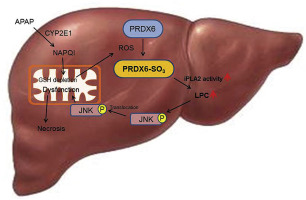Redox Biology ( IF 10.7 ) Pub Date : 2020-03-08 , DOI: 10.1016/j.redox.2020.101496 Dong Hun Lee 1 , Young Suk Jung 2 , Jaesuk Yun 3 , Sang Bae Han 3 , Yoon Seok Roh 3 , Min Jong Song 4 , Jin Tae Hong 3

|
Acetaminophen (APAP) is one of the most frequently used drugs; however, its overdose leads to acute liver injury. Recently, studies have reported that the adduction of peroxiredoxin 6 (PRDX6), a member of the PRDX family of antioxidant enzymes, is associated with liver diseases. However, the role of PRDX6 in APAP-induced liver injury remains unclear. Here, we assessed both age-matched (about 12 weeks) PRDX6-overexpressing transgenic mice (PRDX6 mice) and wild type (WT) mice presenting acute liver injury induced by the intraperitoneal injection of APAP (500 mg/kg). Although PRDX6 is known as an antioxidant enzyme, PRDX6 mice unexpectedly demonstrated severe liver injury following APAP injection compared with WT mice. We observed that PRDX6 was hyperoxidized after APAP administration. Additionally, calcium-independent phospholipase A2 (iPLA2) activity and lysophosphatidylcholine (LPC) levels were markedly elevated in PRDX6 mice following APAP administration. Moreover, APAP-induced JNK phosphorylation was considerably increased in the liver of PRDX6 mice. MJ33, an inhibitor of PRDX6, attenuated APAP-induced liver injury both in WT and PRDX6 mice. Notably, MJ33 reduced the APAP-induced increase in JNK activation, iPLA2 activity, and LPC levels. Although SP600125, a JNK inhibitor, abolished APAP-induced liver injury, it failed to affect the APAP-induced hyperoxidation of PRDX6, iPLA2 activity, and LPC levels. These results suggested that PRDX6 was converted to the hyperoxidized form by the APAP-induced high concentration of hydrogen peroxides. In the liver, hyperoxidized PRDX6 induced cellular toxicity via JNK activation by enhancing iPLA2 activity and LPC levels; this mechanism appears to be a one-way cascade.
中文翻译:

过氧化物酶6通过JNK激活介导对乙酰氨基酚诱导的肝细胞死亡。
对乙酰氨基酚(APAP)是最常用的药物之一。但是,过量服用会导致急性肝损伤。最近,有研究报道,过氧化物酶6(PRDX6)(抗氧化剂PRDX家族的成员)的内含物与肝脏疾病有关。但是,PRDX6在APAP引起的肝损伤中的作用尚不清楚。在这里,我们评估了年龄相匹配(约12周)的过表达PRDX6的转基因小鼠(PRDX6小鼠)和野生型(WT)小鼠,这些小鼠表现为腹膜内注射APAP(500 mg / kg)引起的急性肝损伤。尽管PRDX6被称为抗氧化酶,但与野生型小鼠相比,APDX注射后PRDX6小鼠出乎意料地表现出严重的肝损伤。我们观察到APDX给药后PRDX6被过度氧化。另外,非钙依赖性磷脂酶A2施用APAP后,PRDX6小鼠的(iPLA2)活性和溶血磷脂酰胆碱(LPC)水平明显升高。此外,APAP诱导的PRDX6小鼠肝脏中的JNK磷酸化显着增加。MJ33是PRDX6的抑制剂,可减轻WT和PRDX6小鼠的APAP诱导的肝损伤。值得注意的是,MJ33减少了APAP诱导的JNK激活,iPLA2活性和LPC水平的增加。尽管SP600125(一种JNK抑制剂)消除了APAP诱导的肝损伤,但它未能影响APAP诱导的PRDX6,iPLA2活性和LPC水平的过度氧化。这些结果表明,通过APAP诱导的高浓度过氧化氢,PRDX6被转化为过氧化形式。在肝脏中,过氧化的PRDX6通过增强iPLA2活性和LPC水平通过JNK激活诱导细胞毒性。











































 京公网安备 11010802027423号
京公网安备 11010802027423号